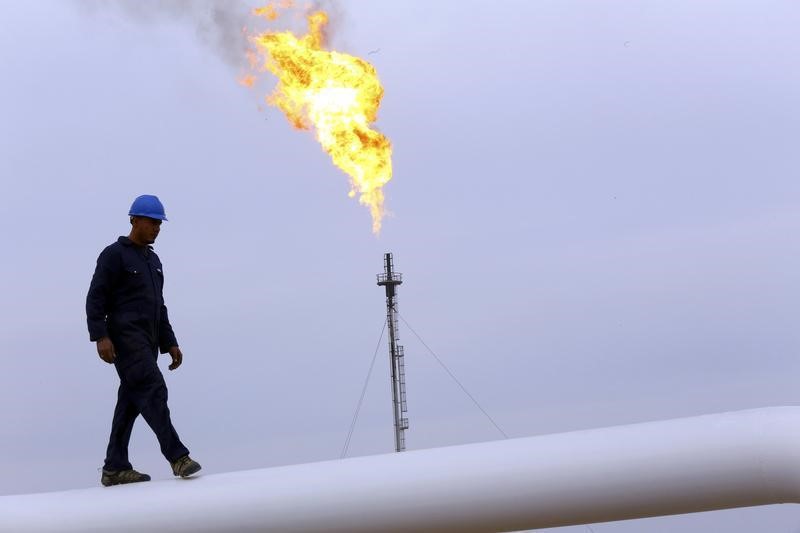Investing
Oil rallies on softer U.S. inflation but down as much as 14% at half-year

© Reuters.
Investing.com – Oil markets rose more than 1% Friday as softer U.S. inflation data suggested the Federal Reserve could be a little restrained in its hawkish talk to rein in price growth via rate hikes.
But while crude futures are also higher for the week and month, they were on course to end the half-year down as much as 14% amid fears of a global recession, triggered by signs that most major central banks will raise rates in the near term.
New York-traded West Texas Intermediate, or , settled up 78 cents, or 1.1%, at $70.64 a barrel. The U.S. crude benchmark was up 2.1% for the week and 3.7% for the month. But for the quarter, it was down 6.6%, while for the year, it showed a loss of almost 14%.
London-traded crude settled up 56 cents, or 0.8%, at $74.90 per barrel. The global crude benchmark showed a gain of 1.5% for the week and 3.8% for the month. For the quarter, it slid 6.1%, while for the year, it showed a deficit of 12.8%.
“The first half of the oil story shows disappointed oil bulls with concerns about rising interest rates, Federal Reserve officials promising a slowdown in the economy, bank failures, perceived weakness in Chinese oil demand and the inability to rein in sanctioned oil from Russia and Iran,” said Phil Flynn, energy analyst at the Price Futures Group in Chicago.
But Flynn, also an ardent oil bull, said the second half could be a story “radically different” and positive for those long crude as the current supply surplus in the market “may turn into a deep deficit.”
Oil bulls count on upcoming Saudi cuts
The bull thesis for oil in the second half is held up by expectations that major producer Saudi Arabia will cut production meaningfully to bring Brent to above $80 a barrel and WTI to at least $75.
The Saudis, who lead the 23-nation alliance of oil producers called OPEC+, have announced three production cuts since October that would theoretically remove 2.5 million barrels per day from their production, bringing output to just around 9 million daily barrels in July.
But crude prices have only rallied briefly after each of those announcements as by the Fed and other central banks have become a factor for the oil market which fears a worldwide economic slowdown that could impact energy demand.
A panel discussion on Wednesday hosted by the European Central Bank and including the heads of the Federal Reserve, Bank of England and Bank of Japan, showed nearly all on board with higher interest rates to curb higher-than-expected inflation.
Fed Chair Powell followed that up on Thursday by telling a banking event in Madrid that the U.S. central bank was trying to find the level for rates that will restrain economic activity and inflation without causing unnecessary weakness.
Latest U.S. gross domestic product data released on Thursday also showed more resilience than thought in the economy, a development that could put more winds behind the Fed’s rate hike sails.
U.S. grew by an annualized 2% in the first quarter of this year, the Commerce Department said Thursday in a revelation likely to add to the Federal Reserve’s relief that its rate hikes had not weighed too much on growth.
Economists polled by US media had forecast a year-on-year growth of only 1.4% on the average for the January-March period. The Commerce Department’s prior growth estimate for the quarter was just 1.3%.
Fed action still something to fear
The Fed has been seeking instead for a “soft landing” of the economy, which translates to slower but not negative GDP growth. The latest quarterly result indicates that the central bank might just get its wish.
Offsetting some of that hawkish Fed mode was inflation data on Friday that came in the form of the Personal Consumption Expenditures, or , Index. The index, a U.S. inflation indicator closely followed by the Fed, grew 3.8% in the year to May, in line with expectations and below the key 4% level for the first time in more than two years.
Aside from global monetary tightening, traditional sources of demand for energy — especially from China, the number one importer of oil — haven’t been as encouraging as thought in the first six months of the year.
Notwithstanding that, Flynn and like-minded analysts think demand for oil could turn the corner in the remainder of the year.
“Oil’s fourth straight quarterly decline should be its last one. WTI crude is trying to stabilize above the $70 level as the oil market is destined for a deficit in the second half of the year,” said Ed Moya, analyst at online trading platform OANDA.
“The crude demand outlook has too much doom and gloom priced in as the US and China outlooks should remain upbeat. China might be buying cheaper discounted Russian crude, but soon they will require more and those purchases could broaden as they slowly deliver more economic stimulus. The key for oil will be if the Saudis remain aggressive in getting this market tighter with an extension or slightly deeper output cuts,” Moya added.
Read the full article here

-

 Make Money6 days ago
Make Money6 days agoHow to Create and Sell Digital Products Online (Make Extra Money)
-

 Investing6 days ago
Investing6 days agoIs Apple Releasing an ‘Ultra-Thin’ iPhone 17 Air? New Report
-

 Investing6 days ago
Investing6 days agoUS data center electricity and water use to increase significantly by 2028: report By Investing.com
-

 Investing5 days ago
Investing5 days agoMoldova breakaway region to face new power cuts on Saturday, officials say By Reuters
-

 Investing5 days ago
Investing5 days agoReebok Co-Founder Backs Syntilay’s New AI, 3D-Printed Shoe
-

 Side Hustles5 days ago
Side Hustles5 days agoHow to Survive High-Demand Seasons Without Losing Customers
-

 Passive Income6 days ago
Passive Income6 days agoHow to Evolve From Manager to Mentor and Create a Lasting Impact
-

 Side Hustles3 days ago
Side Hustles3 days ago5 Things That Could Significantly Impact Your Company in 2025


















